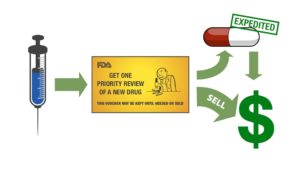The Priority Review Voucher: An Untapped Asset
Oct 3rd, 2018 by David Puleo | Patent Resources | Patent Trends & Activity | Recent News & Articles |
This image is from a video posted by Duke University which can be found here.
Typically, we think of patents as the main tool that allows for product exclusivity in the pharmaceutical industry. However, exclusivity has a regulatory component. For example, a new drug product cannot be marketed until it has undergone review and approval by the US Food and Drug Administration (FDA) or other foreign counterpart. Probably the most familiar regulatory exclusivity is the five years given upon approval of a new drug application (NDA) during which no generic drug application can be filed.[1] This regulatory exclusivity is a valuable asset, so much so in fact that it is often desirable to accelerate the drug approval process. An untapped asset that has arisen out of this framework is the priority review voucher (PRV). A helpful summary on PRVs was recently published in a piece from the Regulatory Affairs Professional Society.
PRVs were first proposed in 2006 by faculty at Duke University to incentivize the development of drug therapies, specifically citing the unmet medical need for treatments against tropical diseases.[2] One year later, the FDA implemented the Priority Review Voucher Program, which allows for expedited review of those drugs treating rare or unmet diseases. The first program, which was created under the FDA Amendments Act of 2007, encouraged development of treatments for disease on the FDA list of tropical diseases, which includes tuberculosis, malaria, and cholera, to name a few. The FDA also has PRV programs for Rare Pediatric Diseases (RPD) as well as for Medical Countermeasures. Interestingly, these vouchers can either be used by the company that originally purchased them or can be re-sold to other companies and, thus, are seen as a valuable asset. The first PRV re-sold for $67M in 2014; the most expensive was sold by United Therapeutics (UT) to AbbVie for $350M. These prices are dizzying, considering that the FDA fees for the initial drug application filers are just north of $2M. Despite this, vouchers have become coveted property.
However, it appears that the value of PRVs has been declining in recent years. Recently, Kyowa Hakko Kirin and partner Ultragenyx sold an RPD PRV to an undisclosed party for for $80.6 million, 3-4 fold less than the aforementioned UT-AbbVie deal. However, it is not readily apparent why the value is decreasing. One reason could be that the FDA has been issuing an increased number of PRVs. Lawmakers see the added value in how PRVs drive innovation and treatments for unmet diseases; their opinions could have contributed to this trend. It is uncertain whether this trend will continue. Nonetheless, PRVs are an important part of a company’s portfolio and are still a valuable bargaining chip and exclusivity asset in the tool box of the pharmaceutical company.
[1] See 21 USC § 355(c)(3)(E)(ii) of this section of the U.S. Code relating to New Drugs. The situation is more complex and other regulatory provisions apply, but the point being made is that the FDA provides for various exclusivity periods for small molecule drugs. Analogous periods of exclusivity are provided under provisions for the Regulation of Biological Products at 42 U.S. Code § 262.
[2] See the seminal paper proposing PRVs can be found here.
–David Puleo and Anthony D. Sabatelli, PhD, JD
This article is for informational purposes, is not intended to constitute legal advice, and may be considered advertising under applicable state laws. The opinions expressed in this article are those of the author only and are not necessarily shared by Dilworth IP, its other attorneys, agents, or staff, or its clients.


